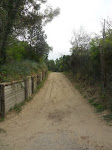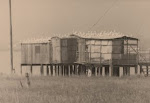Fino ad ora è stato impossibile stabilire con precisione quando l'industria vetraria di Venezia ha iniziato . Una delle possibili teorie links sua prima produzione al periodo in cui il popolo Veneto spostati isole dell'estuario dopo aver vissuto nella fiorente città costiere romane della costa adriatica ( da Adria ad Altino ) e dove avevano imparato le tecniche vetrarie romane Un documento testimonia una datazione notaio 982 è stato firmato da un certo Domenico , che era un " fiolario " , cioè ha fatto del vetro soffiato , principalmente la produzione di bottiglie conosciute come " fiole " . L'unica prova della vetraria veneziana è costituito da frammenti trovati nel 1961-62 insieme con i resti di una fornace durante gli scavi nella " Piazza" di Torcello . Frammenti sono stati scoperti anche nel sottosuolo Murano ( chiesa di San Donato ) e nella laguna stessa Più di recente , tra il 1992-1993 durante gli scavi a Malamocco ( un piccolo posto al Lido ) , alcuni frammenti di ceramica sicuramente databili tra la fine del quarto e l'inizio del 5 ° secolo sono stati portati alla luce , insieme a due tronco di cono - bicchieri a forma arrotondata e una datazione collo lungo bottiglia dello stesso periodo , come quelli esposti in questa sala . Nel corso dei secoli 12 ° 14 ° l'arte del vetro certamente sviluppato attraverso il contatto con Oriente, in particolare la Siria , l'Egitto e l' Impero Romano d'Oriente a seguito di guerre e imprese commerciali Come è documentato , è certo che dagli ultimi 20 anni del 13 ° secolo fino a circa la metà - 14 ° secolo ci fu l'arte di anamelling su vetro a Murano ( Gregorio da Napoli , Bartolomeo da Zara , Donino ) . Nel 13 ° secolo i vetrai avevano uno statuto redatto in latino che ha fissato le norme che controllavano le attività della gilda. Nel 1441 è stato riscritto in volgare e fu chiamato " Mariegola dell'Arte dei Verieri de Muran " . Nel Mariegola ( o Matricola "c'erano regole che coprivano tutte le fasi della lavorazione del vetro - dalla produzione alla vendita , le tasse e le relazioni tra i proprietari , maestri vetrai e altri lavoratori in fabbrica .
Up to now it has been impossible to establish precisely when the Venice glassmaking industry first began. One of the likely theories links its earliest production to the period when the Veneto people moved to the estuary islands after having lived in flourishing Roman coastal towns on the Adriatic (from Adria to Altino) and where they had learned Roman glassmaking techniques. A document witnessed by a notary dating from 982 was signed by a certain Domenico who was a “fiolario”, that is he made blown glass, mainly producing bottles known as “fiole”. The only evidence of Venetian glassmaking consists of fragments found in 1961-62 together with the remains of a furnace during excavations in the “Piazza” of Torcello. Fragments have also been discovered in the Murano subsoil ( the church of San Donato) as well as in the lagoon itself. More recently, between 1992-93 during excavations at Malamocco ( a small place on the Lido), some ceramic fragments certainly dating from between the end of the 4th and the beginning of the 5th century were brought to light, together with two truncated cone-shaped beakers and a rounded long-necked bottle dating from the same period as those on display in this room. During the 12th-14th centuries the art of glassmaking certainly developed through contact with East, particularly Syria, Egypt and the Eastern Roman Empire as a consequence of wars and commercial enterprises. As is documented, it is certain that from the last 20 years of the 13th century until about the mid – 14th century there was the art of anamelling on glass in Murano (Gregorio da Napoli, Bartolomeo da Zara, Donino). In the 13th century the glassmakers had a statute drawn up in latin which laid down the regulations that controlled the activities of the guild. In 1441 it was rewritten in the vernacular and was called the “Mariegola dell’Arte dei Verieri de Muran”. In the Mariegola (or Matricola” there were rules which covered all the phases of glassmaking – from production to selling, taxes and the relations between the owners, glass masters and other workers in the factory.
Up to now it has been impossible to establish precisely when the Venice glassmaking industry first began. One of the likely theories links its earliest production to the period when the Veneto people moved to the estuary islands after having lived in flourishing Roman coastal towns on the Adriatic (from Adria to Altino) and where they had learned Roman glassmaking techniques. A document witnessed by a notary dating from 982 was signed by a certain Domenico who was a “fiolario”, that is he made blown glass, mainly producing bottles known as “fiole”. The only evidence of Venetian glassmaking consists of fragments found in 1961-62 together with the remains of a furnace during excavations in the “Piazza” of Torcello. Fragments have also been discovered in the Murano subsoil ( the church of San Donato) as well as in the lagoon itself. More recently, between 1992-93 during excavations at Malamocco ( a small place on the Lido), some ceramic fragments certainly dating from between the end of the 4th and the beginning of the 5th century were brought to light, together with two truncated cone-shaped beakers and a rounded long-necked bottle dating from the same period as those on display in this room. During the 12th-14th centuries the art of glassmaking certainly developed through contact with East, particularly Syria, Egypt and the Eastern Roman Empire as a consequence of wars and commercial enterprises. As is documented, it is certain that from the last 20 years of the 13th century until about the mid – 14th century there was the art of anamelling on glass in Murano (Gregorio da Napoli, Bartolomeo da Zara, Donino). In the 13th century the glassmakers had a statute drawn up in latin which laid down the regulations that controlled the activities of the guild. In 1441 it was rewritten in the vernacular and was called the “Mariegola dell’Arte dei Verieri de Muran”. In the Mariegola (or Matricola” there were rules which covered all the phases of glassmaking – from production to selling, taxes and the relations between the owners, glass masters and other workers in the factory.









































Nessun commento:
Posta un commento